Sigma Ex 150mm F/28 Apo Hsm Ex Dg Os Review
Sigma 150mm f/ii.eight EX DG Os HSM Macro Lens Review

If you lot are looking for a macro lens that provides not bad image quality, has optical stabilization, has a pocket-size size and weight and offers a relatively long-for-macro focal length in a nicely designed and well-built package, the Sigma 150mm f/2.viii EX DG Bone HSM Macro Lens deserves your consideration. The pocket-size price tag for what you go results in an ever-loved good value.
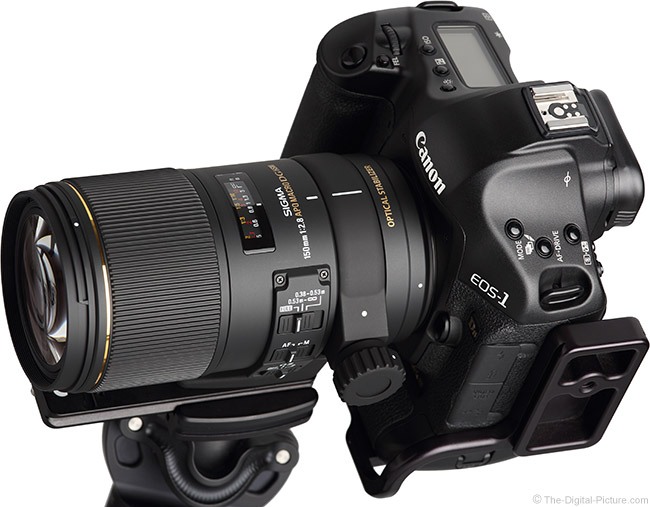
Especially unique for this lens is the focal length. If yous search for a "150mm macro lens" at your favorite online camera retailer, the Sigma 150mm f/2.8 EX DG Bone HSM Macro Lens is the only lens you lot will find. No other lens manufacturer offers a DSLR macro lens in this focal length and fifty-fifty a prime non-macro 150mm lens is not available from Canon, Nikon, Sony, Tamron, Tokina, Zeiss and many other big lens manufacturers. The 150 Os macro replaces Sigma's first 150mm macro lens, the well-liked 150mm f/2.8 EX DG HSM Macro Lens.
The relatively long-for-macro focal length yields a nice amount of working altitude and a corking groundwork compression. The background of your images is very important, and the 150mm angle of view, compared to the more common 100mm focal length, allows less of the groundwork in your image while creating a stronger mistiness of that background. While not offer the shut perspective of a 50mm or similar focal length, I detect myself reaching for longer focal length macro lens most frequently.
The 150mm focal length is not the longest commonly offered by lens makers. Nearly manufacturers (including Sigma) have a 180mm macro lens and Nikon's longest macro is 200mm. The downside is that the longer focal length lenses are all larger, most accept narrower max apertures and virtually are significantly more than expensive than the Sigma 150 Os.
Aperture
The Sigma 150 Os lens' f/2.8 is equal to or wider than all other greater-than-60mm macro lenses with a ane:1 reproduction ratio. When shooting at a very close altitude, the Sigma 150 Os lens' max f/2.8 discontinuity will not ever be considered an advantage unless a very strong mistiness is the goal of the photo. Here is an example of the depth of field delivered by this lens at apertures separated past ane stop.

The imaging sensor was about xvi" from the flower-shaped candy when these images were captured, so the reproduction ratio being shown is very close to 1:1/1.00x. As you can see, there is non much of the frame in focus at f/2.viii. Note that, as with all macro lenses, the effective aperture becomes narrower as very close macro focus distances come into use. The camera's car exposure system will automatically recoup for this loss of low-cal, only manual exposure settings will demand to be adjusted to compensate for this.
Mounting this lens on an ASP-C/1.6x FOVCF sensor format DSLR results in an angle of view equivalent to a 240mm full-frame-mounted lens. The lens does non alter of course, only the total image circle is not utilized. The lens remains a one:ane reproduction ratio (ane.00x Maximum magnification) lens, just the subject is going to cover a larger percentage of the sensor, resulting in a more than-tightly-cropped paradigm.
About all macro lenses are useful for general purpose needs with tightly-framed portraits being one of this lens' strengths. I've used this lens on occasion for mural photography.
The available subjects for a macro lens are extensive and readily available. Sometimes they are correct in forepart of your optics as was this small area of condensation that formed on a kitchen window 1 very cold morning.

The background for the condensation was a monochromatic grayness and white winter woods with snowfall on the ground. Using a creative white residue (2500 One thousand) forth with some contrast increase, I was able to give the paradigm a significantly unlike look.
Your macro subject may also exist establish as close every bit your kitchen cabinet.

A Rogue Flash Gel attached to a Canon Speedlite 600EX-RT Wink provided a lively groundwork colour to the frosted articulate glassware.
Optical Stabilization
Making handheld macro photography more of a reality and assisting in ideal handheld discipline framing is Sigma's Optical Stabilization or "OS". The Sigma 150mm OS Macro lens is Sigma'southward 2nd macro lens to include Bone (the 105mm Os Macro was the first). The ii lenses' Os organisation function very similarly.
When Bone activates, there is a mild but audible dissonance and the same noise is heard once more when Bone turns off. The sound is hard to depict, but allow's say that information technology is a "cuuussshhk". I know, you're thinking "That was fun to say!" Some very light whirring can be heard when OS is active and deeper clunking sounds can sometimes be heard – especially when the lens is moved.
The viewfinder remains stable during Os startup and shutdown, but similar the 105 Bone, the subject field framing wonders effectually slightly. This anomaly is well-nigh noticeable when property the camera in a very stable position. While the corporeality of movement is small, it is annoying nonetheless.
The 150'due south OS requires a second to activate, simply you lot volition know when this has occurred – the viewfinder paradigm will settle and the startup "cuuussshhk" volition complete.
Full disclosure: the Bone unit in my lens failed during the fourth dimension I've had the lens. I was not seeing a stabilized image in the viewfinder and and then Os would non turn off – even if the camera was powered off. The lens had to be removed from the camera to shut down the OS system. Remounting the lens reactivated the same problem.
No worries every bit Sigma The states quickly repaired the lens (5 day repair turnaround) for no charge under warranty.
Full disclosure II: The Os arrangement failed a second time during final Os testing. Aforementioned problem plainly not fixed properly the outset time. This lens has obviously earned another trip to Sigma.
Sigma rates this lens for four stops of shake reduction. Though Sigma did not confirm for me, the iv finish rating is probably non applicable at the closest focusing distances this lens is capable of. The Catechism EF 100mm f/2.8 50 IS USM Macro Lens, with its macro-set up Hybrid IS, is rated for only one-half of its normal iv-stops of shake reduction when used at 1.00x magnification.
My testing shows that I can handhold this lens using shutter speeds as long as i/20 sec., representing about 3 stops of help for me. A high pct of the results captured at longer exposure times were motion blurred, though the comparison images beneath were captured at 1/ten second.

Note that, like the 105 OS, the 150 Os Lens owner's transmission instructs that the OS switch should be in the off position when mounting/dismounting the lens. I make it a dominion to not remove a stabilized lens while Bone is active.
The owner's manual also instructs that Bone be turned off when using the lens on a tripod. This is my standard exercise with all stabilized lenses (except Canon's big white super telephoto lenses).
Os cannot cease an in-motion subject area, merely the mode 2 setting provides stabilization in one direction simply, to allow panning with a subject. While this way volition not likely see much apply in macro photography (panning with a line of marching ants?), it has value for other uses.

Image Quality
Macro lenses every bit a group tend to produce very abrupt images and the Sigma 150mm f/2.8 EX DG Os HSM Macro Lens does likewise. While this is not the sharpest lens at f/ii.viii, it does not perform terribly at that discontinuity. Stop downward to f/4 and the 150 Bone is very sharp across the entire full frame epitome circle. Only slight comeback is seen at f/v.6, but this lens is razor sharp at this aperture.
These results are repeatable and with real world subjects. The f/2.eight to f/four sharpness change is quite noticeable, only it is especially difficult to see the f/5.vi improvement. This lens delivers excellent sharpness and sharpness is not a reason to terminate this lens down further. Diffraction is the next consequence on sharpness seen by stopping downwards.
While it would exist corking to report that f/2.8 image quality is equal to what this lens delivers at f/4, realistically, if you are using f/two.8 at macro focusing distances, most of your frame is probable to be blurred due to the razor thin depth of field.
Expect to see about two stops of vignetting in total frame corners at f/2.viii. While noticeable, this is not a strong corporeality for a fast prime lens. A just-noticeable 1 cease of shading remains at f/4 with negligible amounts at narrower apertures. With under 1 stop of shading in the corners at f/2.viii, APS-C format camera owners will not probable notice much vignetting when using this lens.
CA (Chromatic Aberration) is very well controlled with only a minor amount showing in full frame corners under harsh contrast conditions.
As focal lengths increase, so does the likelihood of flare showing in the site's standard sunday-in-the-corner-of-the-frame flare testing and the 150 Os indeed shows some flare. The amount is neat and is in line with the other lenses tested.
You tin can count on the Sigma 150 Os Macro to keep your straight lines straight equally this lens has negligible baloney. Macro lenses are ofttimes used for re-create piece of work – such every bit copying documents and fine art work. The lack of distortion makes this lens well-suited to this task.
From a bokeh (background mistiness quality) perspective, this lens appears to be good/normal. With its brusk minimum focus distance and moderate telephoto focal length, this lens is definitely able to create a lot of bokeh to look at.

Focusing
Driven by Sigma's HSM (Hypersonic Motor) engineering, the 150 OS Macro focuses quickly. With only some lightly-audible clicking, this lens likewise focuses quietly. Focusing is internal and, always helpful for circular polarizer filter employ, the front element does not rotate.
This lens enables FTM (Full Time Manual) focusing. Focus can be adjusted at whatever time – before or afterwards AF.
A Focus Limiter Switch is provided. Selectable ranges are: 1.25 - 1.74' (0.38 - 0.53m), 1.74' - eight (0.53m - 8) and the full 1.25' - eight (0.38m - 8) focus range. Using a restricted focusing range can reduce focus hunting. I do experience occasional focus hunting with this lens, most oftentimes in the macro range as that is distance I've most-used this lens.
Overall, this lens performs well in the AF section I shot focus accuracy has been skillful.
Depth of field markings are not provided, but magnification ratios are included in the focus distance window.
The manual focusing ring is very nicely sized, is smooth and has the right corporeality of resistance. My lens' MF ring has a very slight amount of play when changing directions. This is annoying when I am focusing on this attribute, just ... information technology has not bothered me much in real use.
The 150° focus band rotation adjusts focus distance a bit quickly for my liking, especially at longer focus distances.
Subjects alter size noticeably as they go into and out of focus. Focus distance markings (ft and yard) are provided in a focus distance window.
That this lens tin can reproduce subjects at life-size on the imaging sensor is what a true macro lens is all virtually. Whatever brandish (or print) you are viewing your images on is likely many times larger than the size of your imaging sensor, which means the subject is rendered at many times larger than life-size (especially if zoomed to 100% pixel level). That this lens tin focus close enough for one:ane/one.00x MM (Maximum Magnification) is not unique to macro lenses, but again, it is one very good reason to add such a lens to your kit.
| Model | MFD | MM | |
| Canon EF 100mm f/2.8 Fifty IS USM Macro Lens | 11.eight" | (300mm) | i.00x |
| Canon EF 100mm f/2.8 USM Macro Lens | 12.ii" | (310mm) | 1.00x |
| Zeiss 100mm f/2 Makro-Planar T* ZE Lens | 17.iii" | (440mm) | 0.50x |
| Nikon 105mm f/2.8G AF-S VR Micro Lens | 12.0" | (305mm) | one.00x |
| Sigma 105mm f/2.8 EX DG OS HSM Macro Lens | 12.3" | (312mm) | 1.00x |
| Sigma 105mm f/two.viii EX DG Macro Lens | 12.3" | (312mm) | 1.00x |
| Sigma 150mm f/two.8 EX DG Bone HSM Macro Lens | xv.0" | (380mm) | 1.00x |
| Sigma 150mm f/two.viii EX DG HSM Macro Lens | fifteen.0" | (380mm) | ane.00x |
| Catechism EF 180mm f/3.5 Fifty USM Macro Lens | xviii.9" | (480mm) | ane.00x |
| Tamron 180mm f/three.5 Di Macro Lens | 18.5" | (470mm) | 1.00x |
| Sigma 180mm f/ii.8 EX DG Os HSM Macro Lens | 18.v" | (470mm) | ane.00x |
| Nikon 200mm f/4D AF Micro Lens | xix.2" | (488mm) | one.00x |
When planning to use a lens at or most its MFD a significant amount of fourth dimension, you need to sympathise working distance and how it affects your photography. The MFD spec is based on the distance from the bailiwick to the imaging sensor. Although the longer focal length lenses are too physically longer, the longer focal lengths nonetheless give you more than working infinite – and make it less likely that you will affright a timid subject away.
You tin utilize this site'southward specs and measurements data to summate the actual from-the-cease-of-the-lens working distance for any lens in the database.
Using the referenced adding shows that the Sigma 150 OS lens' working distance is about vii.4" (186.1mm) – compared to 5.6" (141.6mm) for the Sigma 105 Os. Install the hood and the minimal working distance goes downwardly to 4.viii" (119.5mm) – compared to 3.7" (93.6mm) for the Sigma 105 Os. So, the increase in focal length indeed provides an increase in working distance. That increase appears more pregnant if looked at in terms of per centum increase instead of the distance difference.
To get across 1:1/1.00x MM, utilise one or more extension tubes behind the Sigma 150 Bone Macro. As extension tubes accept a larger MM consequence backside shorter focal length lenses, you will desire to use the larger ETs bachelor. Or better notwithstanding, utilize an extender/tele-converter. The Sigma 150mm f/2.8 EX DG Bone HSM Macro Lens is uniform with Sigma's 1.4x and 2x DG tele-converters. With the ane.4x mounted, this lens becomes a 210mm f/four Os lens with a one.40x MM and information technology becomes a 300mm f/5.6 Bone lens with a 2.00x MM when the 2x is backside it.
The biggest downside to using extenders is that they negatively affect image quality. I suggest stopping the aperture of this lens down at least one stop to get decent results when using extenders. Image quality at 210mm f/viii is quite nice, but f/11 looks all-time at 300mm.
Note that this lens will focus between ane.25 - 1.74' (0.38 - 0.53m) simply in manual focusing mode when tele-converters are fastened.
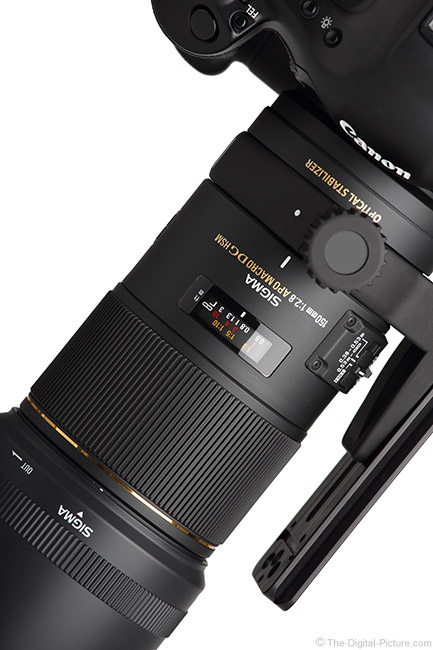
Build Quality & Features
The Sigma 150mm f/2.viii EX DG Bone HSM Macro Lens is 1 of the last lenses introduced prior to Sigma's Global Vision line existence appear. While the new GV lenses are very overnice, the lens blueprint Sigma was using just before GV is also overnice.
This lens has an attractive matte blackness end and a shine overall design. The button panel is raised a pocket-sized amount and raised even more by the Bone switch. Because of the lens design, my hand seldom contacts the raised panel or the switches – peculiarly with the tripod ring in place.

As I said before, there is a little play in the focus ring. Ten or twenty years ago, this amount of play would have been considered excellent. Today, I believe there could exist none.
There is besides some play in the OS manner switch. I would similar this switch, specially since it is a three-position variety, to click more firmly into a locked position. The iii-position focus range limit switch does this.

Included in the 150 Bone box is a tripod ring, assuasive you to ideally balance the photographic camera and lens on a tripod and allowing the lens to be freely rotated as desired (no need to use a ball caput drib notch). Tripod rings are especially great for tripod-based macro piece of work and bully for mounting other attachments to (including wink brackets).
The 150's tripod band is quite polish and is removable even while mounted to the camera thanks to a polish, flush hinge. The lock knob is a short-rotation blueprint, going from locked tight to fully unlocked in about 45°. You may decide to remove this ring when it is not actively being used (such as when shooting handheld) due to the tripod band lock knob and human foot interfering with the lensman'south correct hand when either is rotated into the grip area. Since the lock knob is oriented ninety° from the foot, information technology is not easy to rotate the foot to a completely out-of-the-way position. You lot tin can of course leave the ring in the normal position and utilize the pes as part of your grip method.
Many of the images in this review show a Wimberley P30 Lens Plate mounted to the foot. The P30 is longer than needed, simply it makes a groovy macro slider to use for fine-tuning focus distance in a compatible tripod head clamp. Since the 150 Os' pes has a single threaded insert (this is normal), a lens plate with anti-rotation nubs should be used to preclude the plate from twisting. The P30 is currently Wimberley's longest anti-twist plate.
The 150 OS utilizes a 72mm filter size. Nice is that these are not the largest, nigh expensive filters available and also nice is that many other lenses share this same thread diameter. Apply a footstep-up adapter ring if you already have larger-sized filters (note that the lens hood may non mount of the step-up band).

I capeesh that Sigma includes a lens hood with most of their lenses. I highly recommend using lens hoods and, being modestly long, the 150 OS lens' hood is peculiarly protective from both vivid low-cal and from impact. That this lens hood is narrow means that it stored very compactly when attached in opposite orientation.
Not shown in the images on this folio is the APS-C hood extension that is as well included. The extension better-shades the narrower bending of view utilized by the APS-C sensors.
The Sigma 150 Os Macro comes with a nice zippered, padded nylon instance. All the same, the case is quite large. The APS-C lens hood extension does not reverse on the lens, which means that that case must account for the longer length. There is a large cushion on the bottom of the case to fill the void and afford proper lens protection without the APS-C extension fastened.
This is not a weather condition-sealed lens.
The Sigma 150mm f/two.eight EX DG Bone HSM Macro Lens is a medium-sized lens that remains easy to carry and use. The divergence in size between this lens and the 180mm+ lenses is greater than the weight difference with the heavy Sigma 180mm OS Macro Lens being an exception.
| Model | Weight | Dimensions due west/o Hood | Filter | Twelvemonth | ||
| Nikon 105mm f/2.8G AF-Due south VR Micro Lens | 27.9 oz | (790g) | 3.3 x 4.6" | (83 x 116mm) | 62mm | 2006 |
| Sigma 105mm f/2.8 EX DG Bone HSM Macro Lens | 25.6 oz | (726g) | 3.ane 10 5.0" | (78.three ten 126.4mm) | 62mm | 2011 |
| Sigma 105mm f/2.8 EX DG Macro Lens | fifteen.9 oz | (450g) | 2.ix 10 3.7" | (74 x 95mm) | 58mm | |
| Sigma 150mm f/two.viii EX DG OS HSM Macro Lens | 40.6 oz | (1150g) | three.1 10 five.9" | (79.6 10 150mm) | 72mm | 2012 |
| Sigma 150mm f/2.8 EX DG HSM Macro Lens | 31.6 oz | (895g) | 3.i x 5.4" | (79.6 ten 137mm) | 72mm | 2006 |
| Catechism EF 180mm f/three.5 L USM Macro Lens | 38.5 oz | (1090g) | iii.three x 7.4" | (83 10 187mm) | 72mm | 1996 |
| Tamron 180mm f/3.5 Di Macro Lens | 32.5 oz | (920g) | 3.3 10 half dozen.5" | (85 ten 166mm) | 72mm | |
| Sigma 180mm f/two.eight EX DG Bone HSM Macro Lens | 57.9 oz | (1640g) | 3.seven ten 8.0" | (95 x 203.9mm) | 86mm | 2012 |
| Nikon 200mm f/4D AF Micro Lens | 41.8 oz | (1185g) | 3.0 x 7.6" | (76 x 193mm) | 62mm | 1993 |
For many more than comparisons, review the complete Sigma 150mm f/2.8 EX DG Os HSM Macro Lens Specifications using the site's Lens Spec tool.
Price
The Sigma 150mm f/2.viii EX DG OS HSM Macro Lens is priced more like a 100mm macro lens than the bigger 180mm lenses that vesture also-bigger numbers on their toll tags. While the Sigma 105 Os has a stiff rebate available at review time, the 150 is non much more than expensive than the 105'due south regular cost.
Alternate Macro Lens Choices
Macro lenses are a lot of fun to use and to meet/share the results from. I highly recommend that every kit incorporate at least one of these lenses. There are a lot of macro lenses to choose from and many deliver first-class prototype quality.
I maintain a list of recommended Catechism macro lenses and Nikon of class has their strong contenders.
Hither is a look at the current-at-review-time Sigma macro lens lineup.
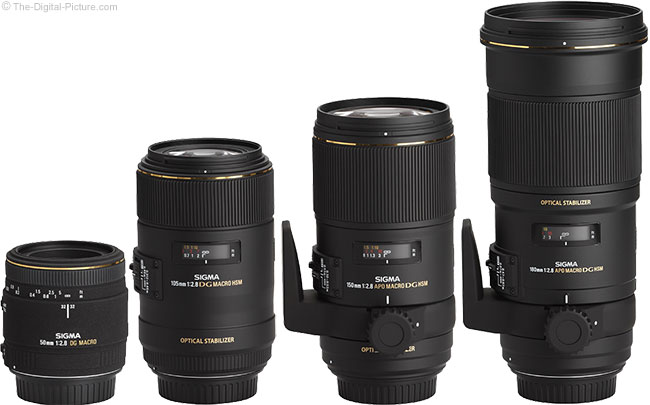
Positioned to a higher place from left to right in their fully retracted positions are the post-obit lenses:
Sigma 50mm f/2.viii EX DG Macro Lens
Sigma 105mm f/2.8 EX DG OS HSM Macro Lens
Sigma 150mm f/2.8 EX DG OS HSM Macro Lens
Sigma 180mm f/ii.8 EX DG Bone HSM Macro Lens
The aforementioned lenses are shown beneath in their fully extended states with their lens hoods in place.
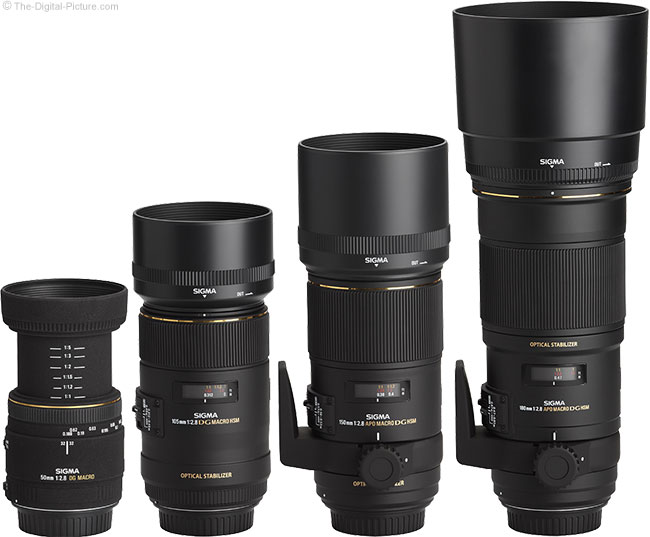
While the 150mm lens is notably heavier than the 105mm selection, the 150 is not much larger than the 105. The Sigma 180mm f/two.8 EX DG OS HSM Macro Lens is the 150 Bone lens' large brother, and the bigger lens will put a noticeably bigger dent in your wallet. The 180 f/2.8 is a larger, heavier lens with a wide f/ii.8 aperture and prototype quality equal to or better than the 150 (especially amend at f/2.8). The 180mm focal lengths will provide a narrower angle of view that besides delivers a stronger background blur (and less background to is included to business organization nearly).
The 180mm lenses also provide more working altitude. The Sigma 180 Os lens' MFD working distance is about 8.8" (221.6mm) compared to 7.iv" (186.1mm) for the Sigma 150 OS and five.half dozen" (141.6mm) for the Sigma 105 Bone. Install the hood and the 180's MFD working distance goes downwards to five.91" (131.0mm) – compared to 4.8" (119.5mm) for the Sigma 150 Bone and three.vii" (93.6mm) for the Sigma 105 OS.
I take not yet fully evaluated the Sigma 180 OS Macro Lens, but it looks nifty in the lab.
Hither is the Sigma 150 Os between Canon and Nikon's long macro lenses.

Positioned higher up from left to correct in their fully retracted positions are the following lenses:
Canon EF 180mm f/3.5 Fifty USM Macro Lens
Sigma 150mm f/2.8 EX DG Os HSM Macro Lens
Nikon 200mm f/4D AF Micro Lens
The same lenses are shown below in their fully extended states with their lens hoods in place.

The Canon weighs less than the Sigma 150 and the Nikon is very slightly heavier.
The Canon EF 180mm f/3.five 50 USM Macro Lens has long been ane of my favorite macro lenses. From an epitome quality perspective, these two lenses are like at the same discontinuity settings. The Sigma has a ii/3-stop wider discontinuity, has Bone and is less expensive.
The long Nikon "micro" lens has a 200mm focal length, just information technology has an MFD spec nearly the aforementioned equally the Catechism 180 L, then the difference in focal length at MFD is very small and non very relevant in comparing. The Nikon appears old in pattern, but it has paradigm quality on par with the remainder of these high-performing lenses. The Sigma has a ane-stop wider aperture, has Os and is less expensive.
Excluded from the comparing images is the Tamron 180mm f/3.5 Di Macro Lens (excluded considering I nonetheless demand to shoot the product images for this lens). The Tamron lens has a big price reward, but does not match the Sigma 150 OS lens' paradigm quality until well-nigh f/eleven. The Sigma has a 2/iii-stop wider aperture and has Bone. If you are simply using narrower apertures (f/8 and narrower), the Tamron may be a good deal for you.
The Sigma 150mm f/2.8 EX DG OS HSM Macro Lens is available in Canon (reviewed), Nikon, Sony/Minolta and Sigma mounts. My standard disclaimer: At that place are potential issues with third party lenses. Since Sigma reverse engineers (vs. licenses) manufacturer AF algorithms, there is always the possibility that a DSLR body might not support a (probable older) 3rd political party lens. Sometimes a lens can be made compatible by the manufacturer, sometimes it cannot be made uniform. There is also the take chances of a problem that results in the lens and torso manufacturers directing blame at each other.
Sigma U.s.a.'s 3-year warranty is superior to Catechism'due south standard 1 yr warranty (Sigma's North and South America warranty is also 1 year). My experience, unfortunately, is that I have needed service for the 150 OS twice and, though no lens is immune from a failure, I take never sent a Canon macro lens for service.
The evaluated Sigma 150 OS was purchased at online at regular price.
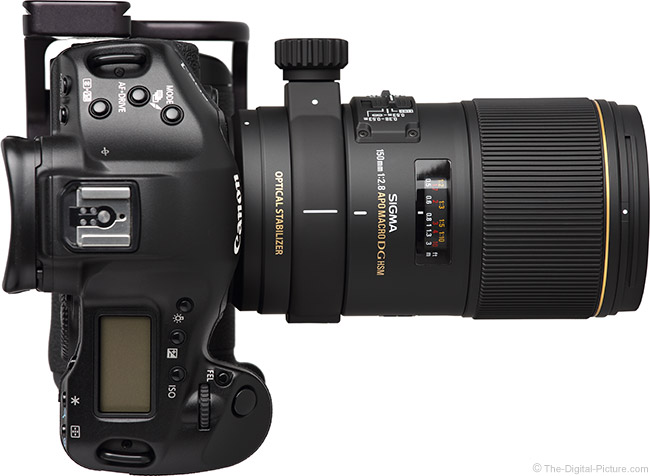
Sometimes a lens is remarkable for what doesn't jump out at you – or get in your way. I have been using this lens intermittently for merely under 2 years. Information technology has reliably delivered first-class images for me. And that is what I expect from a skilful lens – i that I selection to use considering of its attributes, non because I happen to be reviewing it.
I have non kept-secret my dearest for macro lenses and the fun that can be had with them. Aside from the OS failure effect, this lens ranks right up with some of my other favorites. The Sigma 150mm f/2.8 EX DG OS HSM Macro Lens is the great-value of long focal length macro lenses.
Bringing you this site is my full-time chore (typically 60-80 hours per week). Thus, I depend solely on the commissions received from you using the links on this site to make any buy. I am grateful for your support! - Bryan
My Recommended Sigma 150mm f/ii.8 EX DG OS HSM Macro Lens Retailers
Rent the Sigma 150mm f/2.8 EX DG Bone HSM Macro Lens
The Tip Jar
More Sigma 150mm f/ii.8 EX DG OS HSM Macro Lens Related Information
Bryan Recommends Buying It Here
Source: https://www.the-digital-picture.com/Reviews/Sigma-150mm-f-2.8-EX-DG-OS-HSM-Macro-Lens-Review.aspx

0 Response to "Sigma Ex 150mm F/28 Apo Hsm Ex Dg Os Review"
Post a Comment